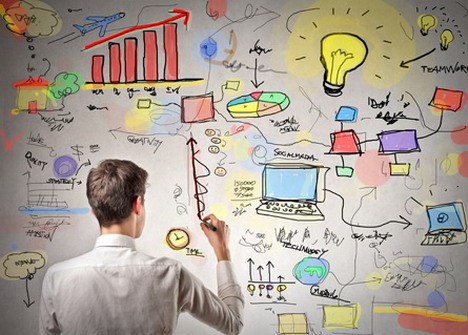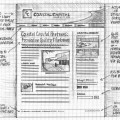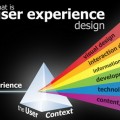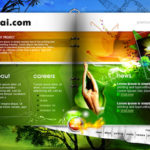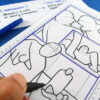Design Thinking as a Strategy for Innovation
Design thinking, what is that? It is definitely another buzzword, but a lot of people don’t really know what it means. To be honest, there are no specific definitions, but they all include a problem solving process that puts identifying people’s needs first. It a method for solving complex problems, design thinking helps organizations find unmet needs and create value from these insights.
Design thinking minimizes the uncertainty and risk of innovation by engaging customers or users through a series of prototypes to learn, test and refine concepts. Design thinkers rely on customer insights gained from real-world experiments, not just historical data or market research. This approach brings together what is desirable from a human point of view with what is technologically feasible and economically viable.
As digital technology becomes more sophisticated and penetrates more parts of our lives, the importance of design thinking increases, too. The last few years we have seen design thinking spread across organisations of all kinds, from education to corporations and governments. As design thinking is an iterative process, normally it is adapted together with agile. While Design Thinking came out of product development and engineering fields, its processes are being adopted by research and development, marketing, and product management departments in many firms across the globe, P&G and Bayer are another examples of it.
7 stages in design thinking process
Building features are simple; however, the real trick lies in forming right features for the right people. The concept allows the designers to pose right questions, create right features and engage with the right people effectively.
You will find different number of stages in companies, but they all go through these steps:
1. Empathise
The first stage of the Design Thinking process is to gain an empathic understanding of the problem you are trying to solve. Here you need to find out more about the area of concern through observing, engaging and empathizing with people to understand their experiences and motivations, as well as immersing yourself in the physical environment to have a deeper personal understanding of the issues involved. Here you need to develop knowledge about what your users do, say, think, and feel.
2. Define
During the define stage, you put together the information you have created and gathered during the Empathise stage. You will analyse your observations and synthesise them in order to define the core problems. But you should define them in a human-centred manner. In this phase you begin to highlight opportunities for innovation.
3. Ideate
During the third stage of the Design Thinking process, designers are ready to start generating ideas. You’ve grown to understand your users and their needs in the empathise stage, and you’ve analysed and synthesised your observations in the define stage, and ended up with a human-centered problem statement. With this solid background you can start to think outside the box to identify new solutions to solve the problem, and you can start to look for alternative ways of viewing the problem. There are hundreds of Ideation techniques such as Brainstorm, Worst Possible Idea, Scamper and many many others. In this phase there are almost no rules, all ideas are welcome and encouraged.
Here you need to give yourself and your team total freedom. Share ideas with one another, mixing and remixing, building on others’ ideas.
4. Prototype
The design team will now produce a number of inexpensive, scaled down versions of the product or specific features. Prototypes may be shared and tested within the team itself, in other departments, or on a small group of people outside the design team. This is an experimental phase, and the aim is to identify the best possible solution for each of the problems identified during the first three stages. The solutions are implemented within the prototypes and, one-by-one, they are investigated and either accepted, improved and re-examined, or rejected on the basis of the users’ experiences. By the end of this stage, the design team will have a better idea of the problems and solutions.
Don’t forget that the goal of this phase is to understand what components of your ideas work, and which do not. Here you begin to weigh the impact vs. feasibility of your ideas through feedback on your prototypes.
5. Test
In this phase, you test the complete product using the best solutions identified during the prototyping phase. Here you put your prototype in front of real customers and verify that it achieves your goals and your user’s ones. Typical questions are “ Does this solution meet users’ needs?”, “ Has it improved how they feel, think, or do their tasks?”, etc. The results generated during the testing phase are often used to redefine one or more problems and inform the understanding of the users, the conditions of use, how people think, behave, and feel, and to empathise. In this phase you ensure that you deal with real user problems and thus avoid creating something that is undesirable.
Within these phases, problems can be framed, the right questions can be asked, more ideas can be created, and the best answers can be chosen.
Key mindsets that govern design thinking
1. Foresight
Avoid getting stuck with your previous work when it comes to ideas. Try to innovate based on your picture for the future. Let the vision pave the way for your thinking.
2. Get Inspired
Go to a place that inspires you. Be around things and people that inspire and set your inspirations for creative ideas. Here you will fin more info about it.
3. Feedback driven
Everything can’t be known in the beginning. Don’t worry about that, it’s ok. But it is important to understand that there are certain answers that strike eventually as you become familiar with the users’ feedback about your product or idea.
4. Learn by doing
Do, do and do. Instead of guessing, create and test. Put your ideas into use, whatever ideas you have, apply them practically and see how they work. Go out and speak with your users, they will give you insights about how the product should look like.
5. Head to Hands
Don’t let your ideas go away. Whenever an idea makes sense, try to work it out. Put your ideas into action through sketching, discussing or prototyping.
6. Visualization
Visual aids are a great source for communicating the information. They give a clear definition to your ideas and establish a great connection with the users.
7. Negative result is a result
Remember it is okay to fail. It helps you to see what you need to skip or avoid doing in the future. Failing you gain valuable experience. Fails also hone your design thinking process.
Advantages of design thinking
- It is a user-centered process that starts with user data, creates design that address real and not imaginary user needs, and then tests those ideas with real users. The idea is to develop useful products and solutions that fit the needs of the user, not the other way around.
- It encourages innovation by exploring multiple solutions for the same problem. It gives you the opportunity to view a problem from a different perspective. Jakob Nielsen says “a wonderful interface solving the wrong problem will fail.” Design thinking encourages creativity and focuses on the right problem.
- Allows you to analyze the problem to determine its root cause. Design Thinking allows you to get to the heart of the matter.
- Ensures that the final outcome meets objectives and client requirements. Design thinking makes sure that you end up launching a product that has undergone numerous rounds of testing and client feedback.
- Enables you to continually expand your knowledge. Design thinking involves its fair share of feedback, ideas and solutions evaluations.
- Iterative process, constant improvement and learning.
We live in an era of experiences, be they services or products, and we’ve come to have high expectations for these experiences. They are becoming more complex in nature as information and technology continues to evolve. With each evolution comes a new set of unmet needs. While design thinking is simply an approach to problem solving, it increases the probability of success and breakthrough innovation.
I think it is very important to teaching kids design thinking, so that they can solve the world’s biggest problems. The next generation will need to be more and more comfortable with problems of increasing complexity. And design thinking can teach them that.
Tags: innovation




